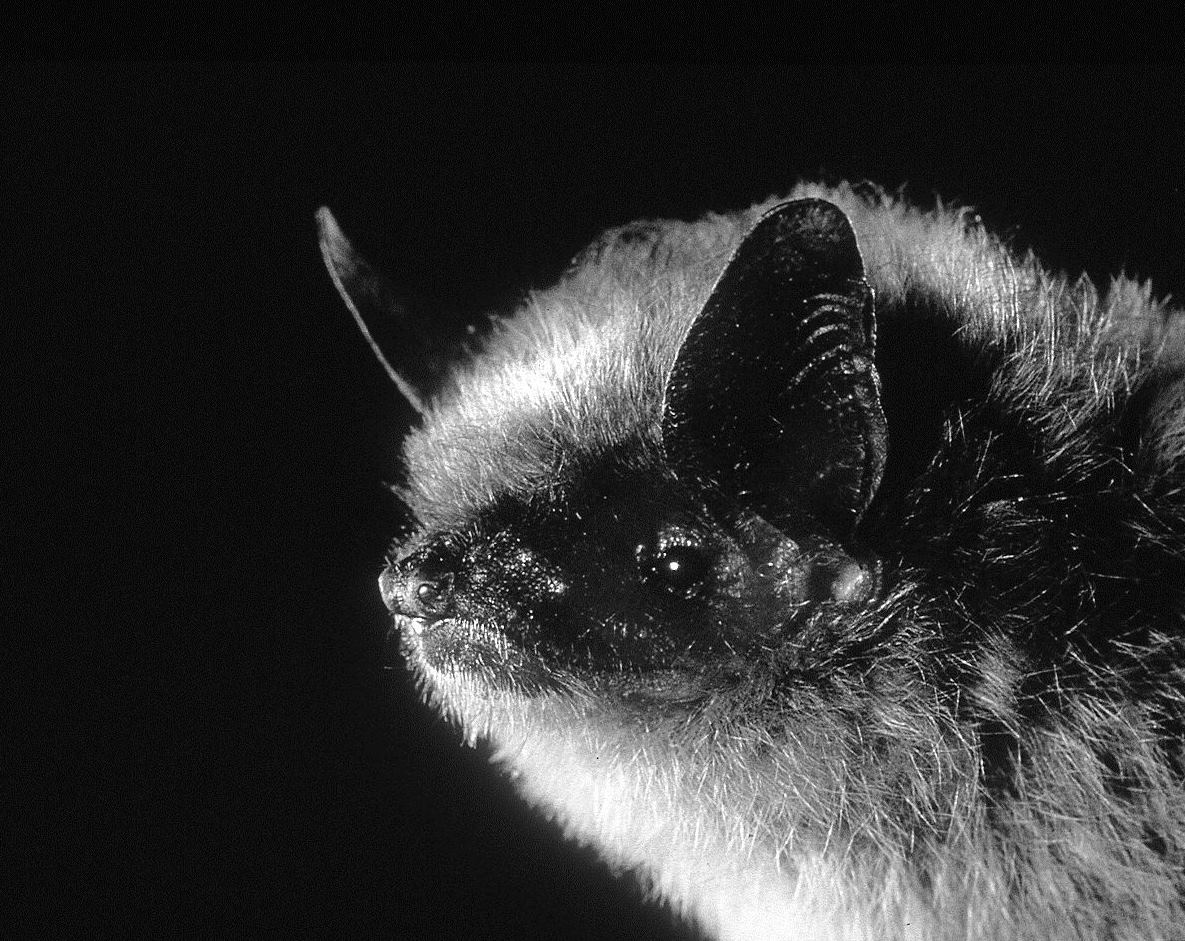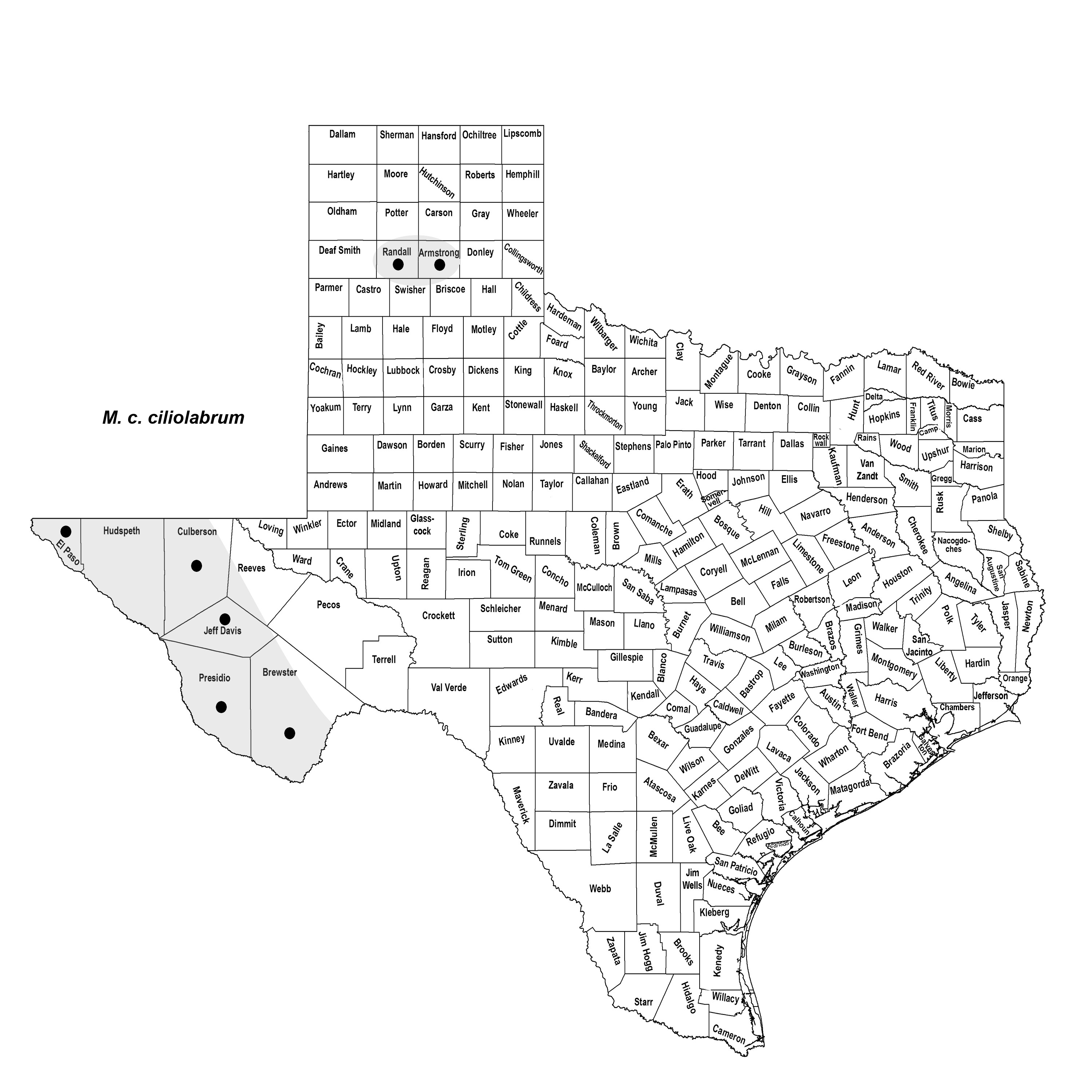WESTERN SMALL-FOOTED MYOTIS
Myotis ciliolabrum (Merriam 1886)
Order Chiroptera : Family Vespertilionidae
DESCRIPTION. A small Myotis with small feet, short ears, and relatively long tail; ratio of tail to head and body about 0.95; ratio of foot to tibia 0.40–0.45; upperparts light buff to warm buff, with slight tricolor effect; individual hairs blackish basally, succeeded by pale intermediate section and flaxen tips; underparts pale buff to nearly white; muzzle, chin, ears, and tragus blackish; sides of face from muzzle to ears blackish brown. Most easily confused with the small-footed M. californicus (see same for differences). Dental formula: I 2/3, C 1/1, Pm 3/3, M 3/3 × 2 = 38. Averages for external measurements: total length, 79 mm; tail, 37 mm; foot, 7 mm; ear, 13 mm; forearm, 33 mm. Weight, 4–5 g.

DISTRIBUTION. The western small-footed myotis is known in Texas primarily from the mountainous regions of the Trans-Pecos region. Single specimens from Palo Duro Canyon, Armstrong County, and Canyon, Randall County, document its presence in the High Plains and Panhandle regions. A small, resident population may occur in the vicinity of Palo Duro Canyon.

SUBSPECIES. Myotis c. ciliolabrum.
HABITS. In the western United States, these bats are inhabitants of the deserts, semideserts, and desert mountains. Their daytime roosts may be in crevices and cracks in canyon walls, caves, mine tunnels, behind loose tree bark, or in abandoned houses. Apparently these bats do not winter in Texas, as specimens have been taken only from March through July. In other parts of their distribution, they are known to hibernate in suitable caves or mine tunnels within their summer range. Bats observed in winter are often found wedged deeply into narrow cracks and crevices in the rock ceilings of old mines. When probed from these crevices they are able to fly, which indicates they do not go into a deep winter sleep.
Western small-footed myotis eat moths, flies, beetles, true bugs, and ants, and where the species occurs with the California myotis, it tends to forage in different areas, often over rocky arroyos, and on different species of prey. They may feed over water and close to the ground over desert chaparral vegetation. This bat is strong enough to take off from the surface of water.
This bat follows a typical pattern of mating in the fall, sperm storage in the winter, and fertilization following ovulation in the spring. Records indicate that the single young born annually appears in late May to early July and begins to fly about 1 month later.
POPULATION STATUS. Uncommon, spring–summer resident. This is a relatively uncommon bat in the western part of Texas, and there is not enough information available to determine its status accurately. For that reason, the western small-footed myotis is a species that should be monitored in the future.
CONSERVATION STATUS. The IUCN status of the western small-footed myotis is least concern, and it does not appear on the federal or state lists of concerned species. It is considered to be in good conservation shape because of its wide distribution, apparently stable population, and occurrence in a number of protected areas.
REMARKS. Scientists have had a difficult time determining the correct name of this species, as explained in the following account taken from The Smithsonian Book of North American Mammals (1999, p. 87): "It was known for years as Myotis keenii and was believed to occur throughout much of the United States and Canada. Later, it was called M. subulatus, and was divided into 3 races: leibii, subulatus, and melanorhinus. Subsequently, van Zyll de Jong showed that there were 2 species of small-footed bats: Myotis leibii in eastern North America and M. ciliolabrum in the west. M. ciliolabrum is divided into 2 subspecies: ciliolabrum and melanorhinus. Because of this confusion, one must be careful to determine whether a given author is discussing eastern or western small-footed myotis." Early editions of The Mammals of Texas referred to these bats as either M. subulatus or M. leibii.
From The Mammals of Texas, Seventh Edition by David J. Schmidly and Robert D. Bradley, copyright © 1994, 2004, 2016. Courtesy of the University of Texas Press.
Natural Science Research Laboratory
-
Address
Museum of Texas Tech University, 3301 4th street, Lubbock, TX 79409 -
Phone
806.742.2486 -
Email
nsrl.museum@ttu.edu

